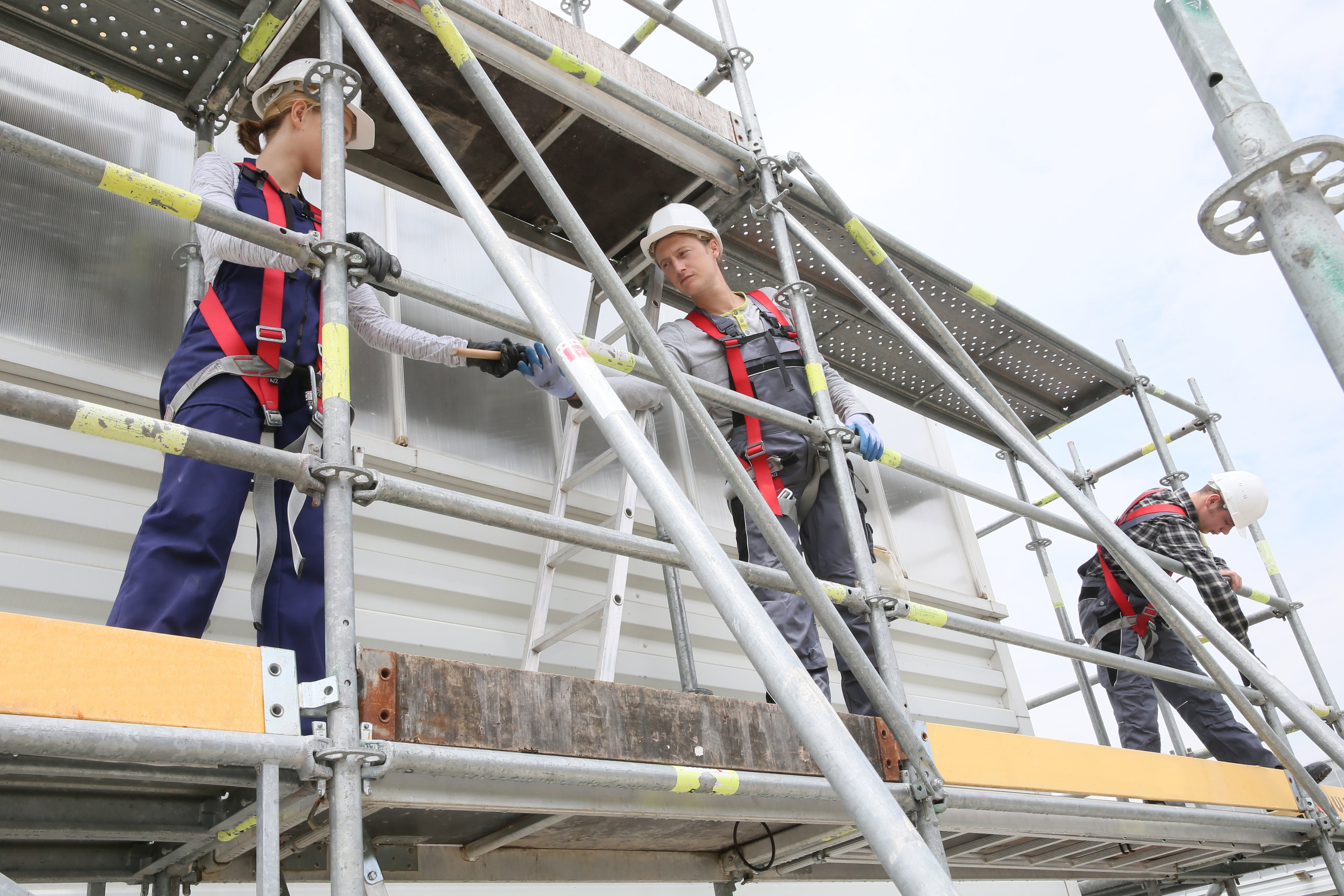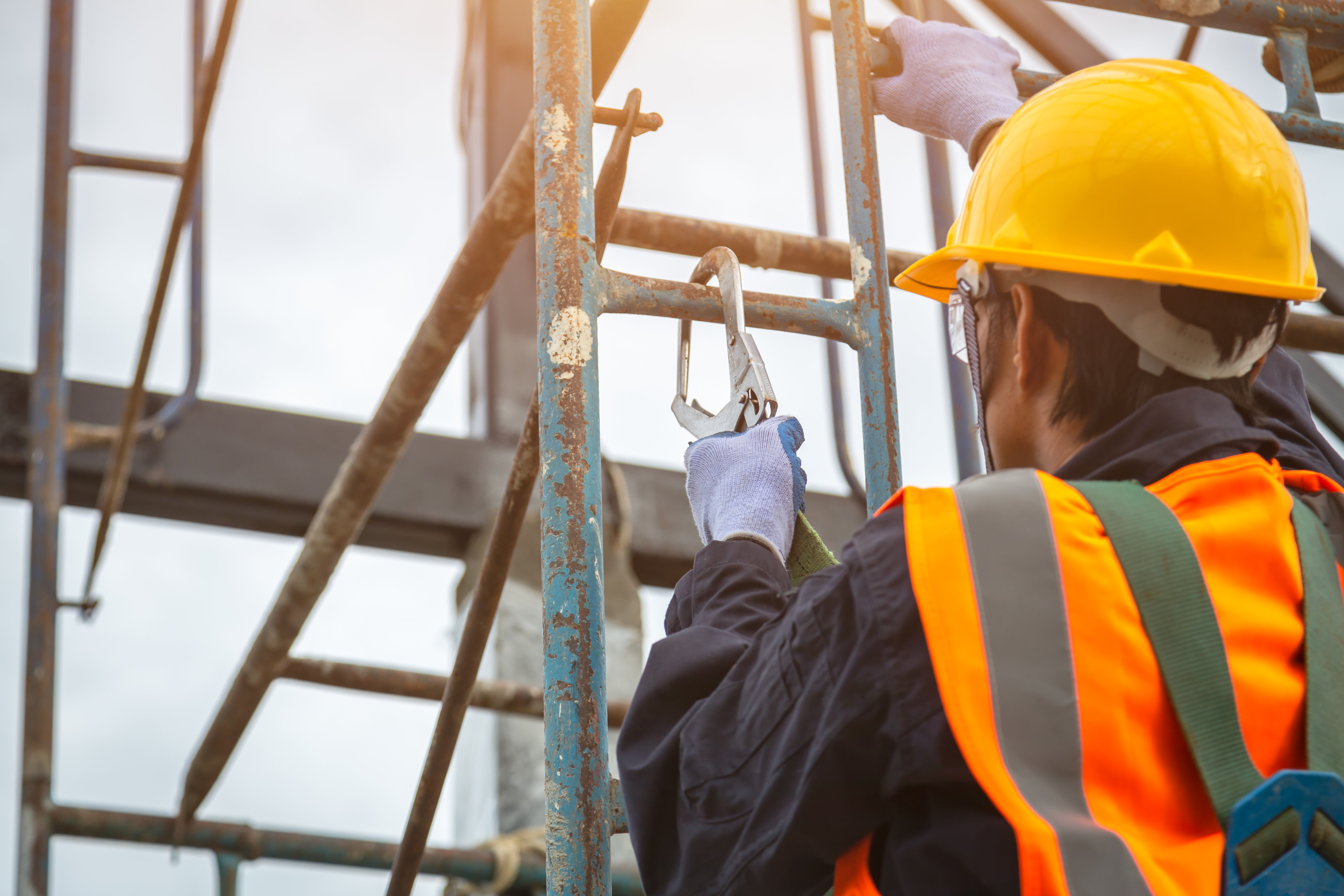A Guide to Scaffolding Safety
Scaffolding is essential in construction, but improper setup and use can lead to serious injuries or fatalities. Hazards include falls, structural failure, falling objects, electrocution and misuse of equipment. Adhering to strict safety standards, routine inspections and regulatory compliance is not just best practice, it’s required. Workers must be properly trained, gear must meet industry standards and procedures must be followed to ensure every task is performed without unnecessary risk.
What is scaffolding?
Scaffolding is a temporary elevated work platform that allows safe access to areas of buildings or structures that are high or hard to reach. It’s used to support workers, tools and materials during a variety of construction projects. For example, painters may use suspended scaffolding for multi-story buildings, while bricklayers often rely on frame scaffolds for exterior walls. Proper scaffolding enables efficient work while reducing fall hazards if used correctly.
Types of scaffolding
Types of scaffolding include:
- Frame scaffolding is commonly used in residential and commercial work; it’s easy to assemble and ideal for straightforward vertical access.
- Suspended scaffolding hangs from roofs with ropes or cables and is often used for window washing and tall buildings.
- Rolling scaffolding is equipped with wheels for easy repositioning, making it ideal for indoor work.
- Tube and coupler scaffolding is highly customizable and strong; it’s used for complex or irregular structures.
- System scaffolding has a modular design with universal parts, so it’s quick to assemble. It’s commonly used in large industrial projects.
The type of scaffolding will also impact the safety procedures that need to be followed. For example, in the case of suspended scaffolding, you should always inspect suspension ropes and platforms before use. Workers should also wear fall arrest systems anchored independently of the scaffold and ensure proper counterweights and secure rigging to prevent tipping or collapse. Meanwhile, in the case of system scaffolding, you should check that all modular components are correctly connected and locked, and use base plates and mudsills for stability on uneven ground.
Types of mishandling and misuse
Some of the common ways scaffolding is misused are:
- Overloading: Don’t ever place excessive weight beyond the capacity of the scaffold. It’s crucial to follow the manufacturer’s guidelines to keep people safe.
- Improper assembly: Failing to lock joints or level platforms correctly makes scaffolding unsafe for everyone. Always double-check the setup and ensure it’s assembled correctly.
- Climbing cross braces: Cross braces aren’t designed for foot support; climbing them is dangerous. Always use ladders or stairs to avoid falls.
- Adding height illegally: Stacking materials or makeshift platforms may seem like a simple way to add height to scaffolding. However, these added structures are unstable and can lead to falls. If extra height is needed, use extensions rated for the scaffold.
- Poor housekeeping: Never leave tools, work materials or any kind of debris on platforms; keep work areas clear so people can navigate the scaffold safely and to reduce the risk of injuries from falling objects.
It is important to properly train everyone on the worksite to avoid these mistakes and adhere to safety best practices.

Regulations and requirements
Compliance is vital in any construction environment. The Occupational Safety and Health Administration (OSHA)(opens in a new tab) sets forth detailed scaffolding requirements under 29 CFR 1926 Subpart L(opens in a new tab). Key rules include fall protection at heights above 10 feet, load-bearing design specifications and mandatory inspections.
OSHA violations like missing guardrails, untrained workers, and failure to use fall protection are frequent citations. Maintaining clearly printed, legible tags on scaffold structures ensures clarity and compliance across worksites.
-
Scaffolding weight capacity
Each scaffold and hoist system has a defined weight limit, typically based on a 4:1 safety factor. Overloading can lead to deadly structural collapse. Always include the weight of workers, tools and materials in your calculations.
Anchor suspended scaffolds to stable, rated points to help prevent tipping. Secure base plates and tie-ins are essential to withstand lateral forces, especially in high winds or variable loads.
-
Inspections
Inspections should be conducted by a competent person before each shift and after any incident or weather event. A competent person is someone with knowledge, experience, and authority to recognize potential workplace safety hazards. These inspections check for damage, instability, missing components and debris. Preparing for formal inspections includes maintaining logs, using OSHA-compliant inspection tags and scaffold tags to verify proper assembly.
Inspecting employees should ensure guardrails are intact, platforms are level and clear, and anchor points are secure. Use standardized procedures and tag systems to clearly communicate scaffold status and readiness for use.
-
Standards and best practices
Best practices for safely using scaffolding include the following:
- Inspect scaffolds before every shift.
- Keep platforms free of snow, ice, debris and tools.
- Never use boxes or ladders to gain extra height.
- Do not climb diagonal braces or use rails as steps.
- Use fall arrest systems on suspended and tall frame scaffolds.
- Secure all components and tie scaffolds to structures to prevent movement.
- Protect against falling tools with toe boards and debris netting.
- Use components from the same manufacturer to ensure compatibility.
Further safety standards may need to be observed depending on the specifics of the area and project. For example, on a high-rise construction site in a windy urban area, additional tie-ins may be required to secure scaffolding to the structure at more frequent intervals. Wind screens or netting might also be installed to reduce sway, and workers should follow strict protocols for securing tools and materials to prevent falling objects, and a spotter may be needed to manage foot traffic below.
-
Scaffolding gear and materials for safety
Gear and materials that can help maintain safety while using scaffolding include:
- Scaffold frames are the structural base; they must be level and secured with base plates.
- Guardrails and toe boards prevent falls and dropped object hazards.
- Braces and crossbars provide lateral support and structural integrity.
- Personal fall arrest systems (PFAS), like harnesses and lanyards, are used when fall protection is required.
- Tags and labels indicate inspection status and safety conditions. Use OSHA-compliant materials.
- Industrial label printers are essential for generating legible, durable tags for lockout/tagout and scaffold identification. Portable label printers are also necessary for many projects.
- Debris netting protects people below from falling objects.
It is important to ensure that these materials are carefully maintained and properly used.
Which factors cause most accidents on scaffolds?
Factors that most commonly cause accidents on scaffolds include:
- Falls from heights due to missing guardrails or fall protection;
- Poor weather conditions, like lightning, high wind, ice or snow;
- Slips and trips from clutter or slick surfaces;
- Dropped tools or equipment;
- Improper assembly or overloading.
You should always make it a priority to stay aware of your surroundings to avoid hazards on a work site.

Scaffolding safety checklist
Before setup, do the following:
- Confirm that trained personnel are present.
- Verify all components are compatible and undamaged.
- Use proper base plates and anchor points.
- Ensure weight loads are calculated and documented.
- Attach visible tags indicating inspection status during use.
- Keep platforms clean and clear.
- Use guardrails, fall protection and toe boards.
A complete checklist helps ensure safe setup and daily use.
Conclusion
Minimizing the hazards of scaffolding is critical for a safe and compliant workplace. From careful setup to regular inspections, every step reduces the risk of serious injury or citation. Tools like tags and industrial label printers play a vital role in maintaining communication, clarity and OSHA compliance. Make scaffolding safety a daily priority — your team depends on it.
